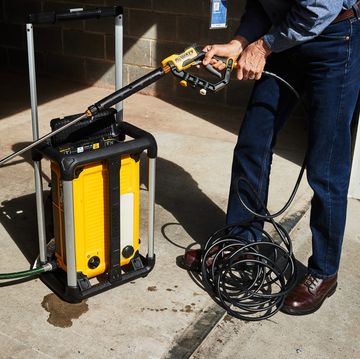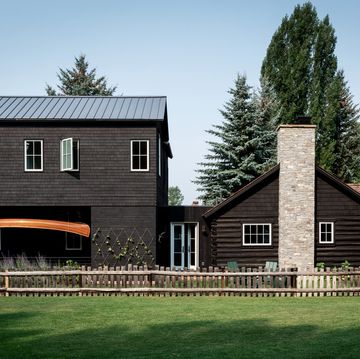If you've always wanted a backyard pond, you're not alone. Hundreds of thousands of homeowners already have them and thousands more are installing them every year. Why all the fuss over a water-filled hole? Well, for one thing, gurgling waterfalls are inherently appealing. Also, with the growing popularity of "water gardening," many people look at their ponds as an interesting, ongoing project.
But before you can start stocking aquatic plants and animals, such as fish, frogs, tadpoles and snails, you need the pond itself--and a source for supplies and equipment. For help on our project, we turned to James S. Hosking Nursery, Watertown, CT; www.hoskingnursery.com.
Keep in mind that the project doesn't have to be huge. The average pond measures about 11 x 16 ft., but it can be built to virtually any size. In some designs, water trickles down a long, meandering stream before emptying into the pond. Many smaller ponds, like the 6 x 8-ft. kidney-shaped one shown here, don't have streams; water runs over a large flat rock and spills directly into the pond. This style is easier to build and can fit into the smallest yards. Basically, such a pond is just a hole lined with rubber, plus some tubing and a pump that's powered by a cord from the house.
Digging It
Once you've chosen a location for the pond, lay out the perimeter using rope or a garden hose. Next, mark the outline with ground limestone and start digging. Excavate to a depth of 16 in., piling the dirt at the rear of the pond, where the waterfall will be located. In the center of the pond, dig down another 10 in. to form a pit where the pump will go.
Now, line the hole and the pit with screened mason's sand and rake it smooth. On top of the sand, place the geotextile fabric that protects the pond liner. Buy a piece big enough to cover the bottom of the hole, the pump pit and the walls. The sand and geotextile will cushion the flexible rubber liner, protecting it from punctures.
Laying Rubber
Fold the rubber liner lengthwise, center it over the hole and unfold it. The liner should overlap equally on all sides. Using your hands and bare feet, carefully press the liner into the hole. Then, use a garden hose to fill the center pit with water to hold the liner in place.
We built this pond out of red New England fieldstone, which is relatively flat and easy to stack. When dealing with this much stone--more than 6000 pounds--you want to handle it as little as possible, so be sure the nursery or masonry supplier delivers the stone directly to the pond site.
Start stacking stones on the pond floor, also called the plant shelf (to differentiate it from the pump pit). Lay the stones in a foot-wide layer along the wall. Overlap the stones between courses and use smaller stones to fill any sizable gaps.
Next, set the pump's hose in position so that it extends from the center pit to the top of the hole. Carefully lay stone directly over the hose. Continue stacking stones until they're even with the ground. Set a single layer of flat stones along the plant shelf, aligning them flush with the edge of the center pit. Then, place one flat rock in the bottom of the pit to serve as a base for the pump.
Next, connect the pump to its hose and set the pump on a flat stone in the bottom of the pit. Check with an electrician to ensure a safe installation of your pump and power cord. Here, the pump's power cord ran through openings between and under stones to a GFCI-protected electrical outlet with a weatherproof cover that shields the plug while it's connected. Don't damage the cord under a stone. Now, use a hose to fill the pond to within 3 or 4 in. of the coping stones.
Next, set large, flat rocks--called coping stones--around the perimeter. Stack stones at the rear of the hole to form the waterfall. A good rule of thumb is to build it to about 12 to 18 in. above the water level. Set the waterfall weir in place atop a large, flat rock (the spillway stone) that is tipped forward slightly. Connect the weir's hose to the pump's hose coming out of the pond. Trim the rubber pond liner to match the waterfall opening at the front of the weir, then attach the liner to the weir using its screw-on faceplate. Backfill around the weir with dirt and continue piling up rocks around the waterfall area. Conceal the weir by placing a rock on top of it.
Once all the stones around the weir are set, secure them with waterproof black foam sealant. Also apply a thin bead of the sealant under the lip of the waterfall weir to adhere it to the spillway.
Plugging In
Fill the spaces between the stones on the pond floor with 3 1/4-in. river rock. Then, take a hose and wash down the stonework around the entire pond. Pump or bail the dirty water from the pit.
Next, connect the pump to its hose and set the pump on a flat stone in the bottom of the pit. Check with an electrician to ensure a safe installation of your pump and power cord. Here, the pump's power cord ran through openings between and under stones to a GFCI-protected electrical outlet with a weatherproof cover that shields the plug while it's connected. Don't damage the cord under a stone. Now, use a hose to fill the pond to within 3 or 4 in. of the coping stones.
Once the pond is filled, plug in the pump. In a few seconds, water will gently spill out of the weir.
border="0" cellspacing="2" cellpadding="0" bgcolor="#cccc99">
Pond Safety
Ponds, especially those stocked with fish and frogs, are inviting to small children and can constitute a drowning hazard. Your building department may require your pond to be fenced in. Check before you build. A pond that is adjacent to a path also can pose a tripping hazard, especially at night. In such an area, the path should be illuminated with low-voltage lights.
It took about two days--and 3 tons of fieldstone--to build this tranquil pond. POND CONSTRUCTION BY JAMES S. HOSKING NURSEY, WATERTOWN, CT. WWW.HOSKINGNURSERY.COM // PHOTOGRAPH BY MICHAEL COGLIANTRY.
Joe is a former carpenter and cabinetmaker who writes extensively about remodeling, woodworking, and tool techniques. He has written eight books and is a contributing editor to Popular Mechanics. He also appears on the Today’s Homeowner TV show, and co-hosts the weekly Today’s Homeowner Radio Show. Joe writes from his home in Roxbury, Connecticut.













